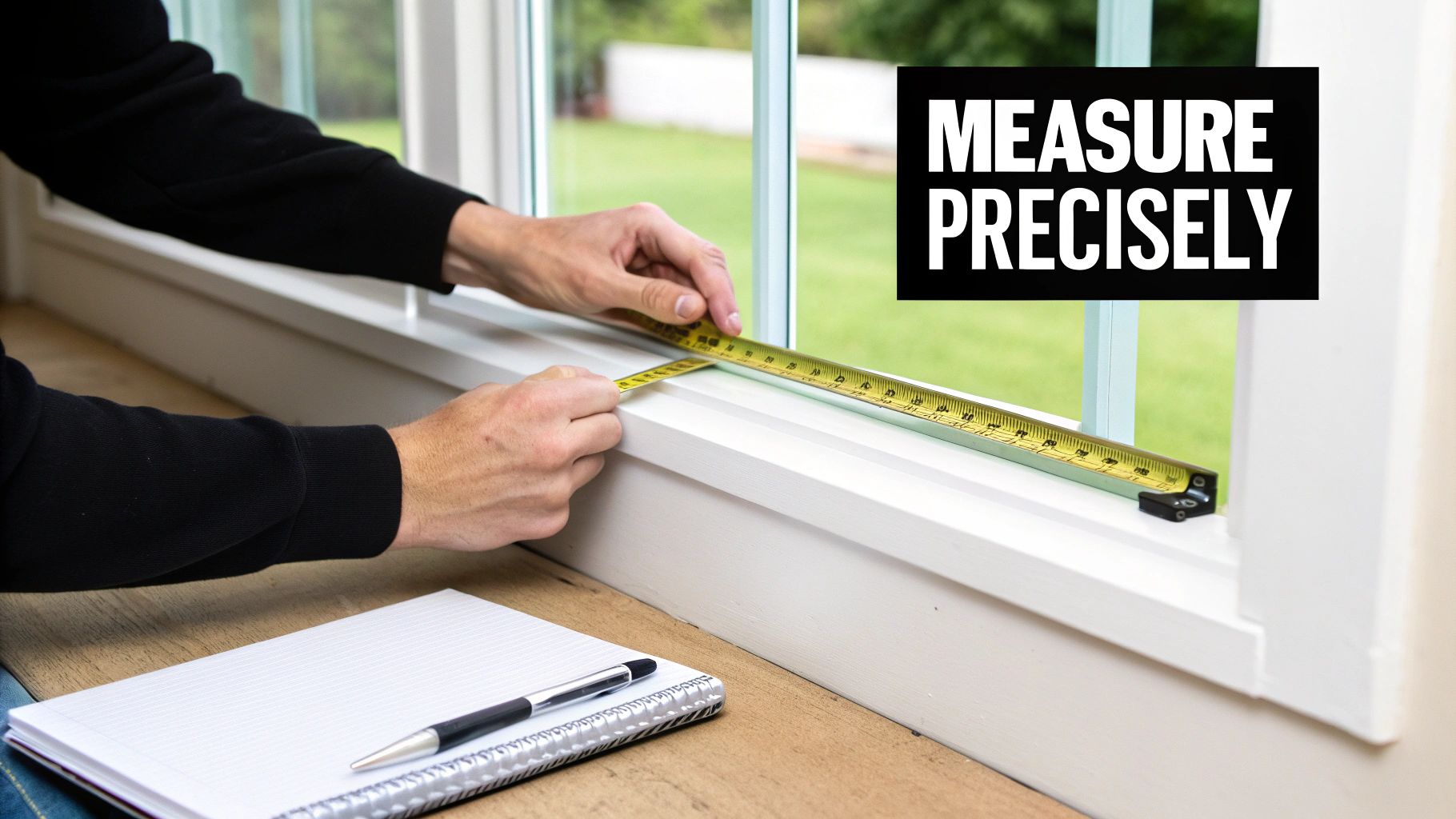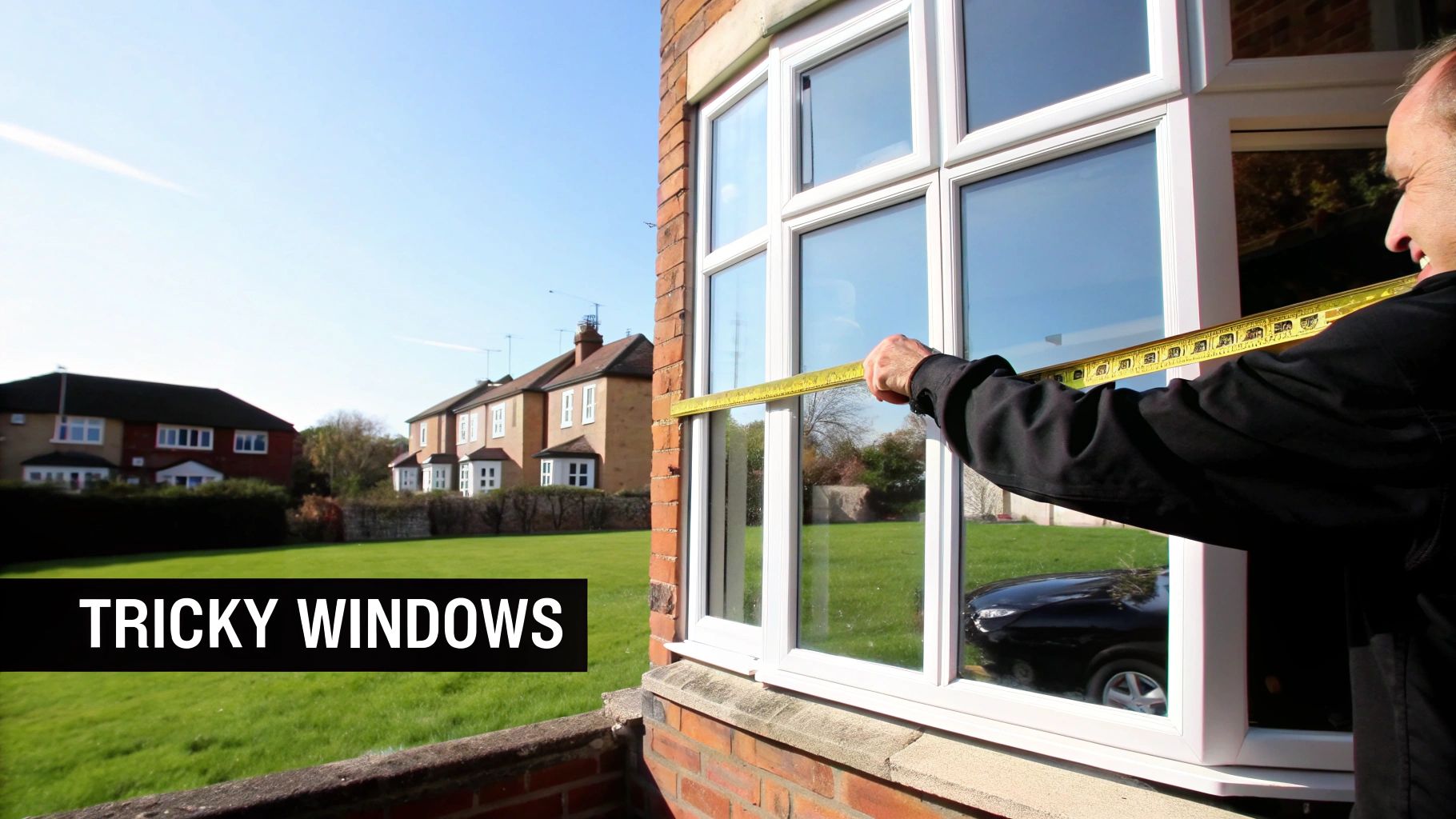How to Measure Windows for Blinds A Perfect Fit Every Time
- Blindsmart im
- Nov 4
- 9 min read
Before you grab your tape measure, let's talk about why getting this step right is so important. A few millimetres here or there can be the difference between a beautifully finished window and a blind that just looks… off. It might catch on the frame, hang awkwardly, or let in those annoying slivers of light you were trying to block.
Why Perfect Measurements Matter for Your Blinds

Getting the measurements wrong is more than just a small headache; it often leads to real disappointment and wasted money. Imagine spending your hard-earned cash on a gorgeous blackout blind, only to find a gap down the side that lets the morning sun stream in, completely defeating the purpose. Or picturing a sleek Venetian blind that ends up scraping against the window recess every time you open it, damaging both the blind and your paintwork.
The Cost of a Small Mistake
You might be surprised how often this happens. According to a 2024 survey from a major UK blinds retailer, a staggering 42% of DIY customers measured their windows incorrectly on their first try. This just goes to show how easy it is for a tiny error to cause a big problem. You can dig into more industry stats like this in this UK digital marketing benchmark report.
Believe me, taking an extra two minutes to double-check your numbers now is far less hassle than trying to arrange a return or living with a blind that never quite fits right.
Getting the Function and Finish You Paid For
Beyond just how they look, accurate measurements are key to how well your blinds work and how long they last. This is particularly true for many UK homes, where you often have to navigate tricky window handles, vents, or deep sills.
For specialised systems like no-drill blinds, precision is absolutely critical. You can see how these work in our guide to Perfect Fit and INTU blinds. Ultimately, a well-measured blind hangs perfectly, operates smoothly, and will look fantastic for years to come.
Right, before we get to the actual measuring, let's get our kit sorted. You won't need to raid a toolbox, but grabbing the right couple of items now will save you a world of headaches later. Honestly, getting this part right is half the battle.
First things first, you absolutely need a good quality metal tape measure. Forget the fabric one from the sewing box or that flimsy plastic ruler. They can easily sag or stretch, and even a few millimetres of error can throw off the whole fit of your blind. A sturdy metal tape gives you the dead-straight, accurate measurement you need.
You'll also want a pencil and a notepad. It might sound basic, but don't try to be a hero and keep all the numbers in your head, especially if you're measuring multiple windows. It's a surefire way to get mixed up.
A Quick Tip from Experience: Get into the habit of writing down the Width (W) first, then the Height (H). Always. This little bit of consistency prevents any confusion when it's time to order. Something like "Living Room Window: W 1205mm x H 1050mm" is perfect – clear, simple, and mistake-proof.
Measuring for Inside Mount Blinds: The Recess Fit
An inside mount, what we in the trade often call a recess fit, is a brilliant choice if you’re after a clean, built-in look. The blind sits snugly inside the window opening, giving you a minimalist finish that really shows off your window frame. But getting it right is all about precision—there’s not much wiggle room.
First things first, have a quick look inside your window frame. Is it completely clear? You need to check for anything that might get in the way, like bulky window handles, alarm sensors, or even air vents. If you spot an obstacle, the blind might not be able to move freely, and you might have to think about a different type of blind or switch to an outside mount.
This infographic shows the simple but essential tools you'll need to get started.

Honestly, having these three things ready before you start just makes the whole process smoother and helps you sidestep some really common mistakes.
Finding the Correct Recess Width
I’ve measured thousands of windows over the years, and I can tell you this: they’re almost never perfectly square. This is especially true in older British homes. That’s why you absolutely must measure the width in three separate places to account for any little variations.
Grab your metal tape measure and check the width right at the top of the recess, from one side to the other. Note it down. Then do the same across the middle, and finally, measure across the bottom, just above the sill.
You should now have three width measurements.
Here's the most important tip I can give you for an inside mount: always use the narrowest of the three width measurements. This is the golden rule. It guarantees your blind won't be too wide, so it won’t catch or scrape against the sides when you use it.
Let's say your measurements look something like this:
Top: 1205mm
Middle: 1202mm
Bottom: 1204mm
In this case, you would use 1202mm as your final width. When you place your order, just give us this exact recess size. We handle the small deductions needed for the mechanisms, ensuring a perfect fit.
Determining the Recess Drop
Just as with the width, the height—or 'drop'—of your recess can be inconsistent. You'll need to follow the same three-point measuring process to make sure the blind doesn't end up too long and bunch up on the windowsill.
Measure the vertical height from the top of the recess down to the sill. Take one measurement on the left, one in the centre, and one on the right. Jot down all three numbers.
Again, once you have your three figures, the one you need is the shortest.
Left: 1508mm
Centre: 1510mm
Right: 1506mm
For this window, the correct drop measurement to provide is 1506mm. This makes certain the blind hangs perfectly straight without dragging on the sill. Taking the time to do these steps properly is the real secret to getting that professional-looking finish everyone wants.
Measuring for Outside Mount Blinds: The Exact Fit
An outside mount, which we often call an exact fit, is the perfect solution when fitting a blind inside the window recess just won’t work. Perhaps the window frame isn't perfectly square, you want to block as much light as possible, or the recess is too shallow to hold the blind's mechanism. By fitting the blind to the wall or trim around the window, you cover the entire opening.
The beauty of an outside mount is that you're in complete control of the final size. Unlike a recess fit where you're stuck with the dimensions of the opening, here you decide how much the blind will overlap the window. Getting this overlap right is the secret to a professional finish and better light control.
How Much Overlap Do I Need?
This is the most common question I get, and it's the most important one for an exact fit. As a solid starting point, I always recommend adding at least 70mm of overlap to each of the four sides of the window recess. This gives you great coverage and dramatically reduces the light that can peek around the edges.
Think about a real-world scenario: you're fitting a blackout blind in a bedroom. Here, any sliver of light can be a nuisance. In this case, I’d suggest increasing the overlap to 100mm on all sides. That extra coverage creates a fantastic light seal, making the room properly dark for a decent night's sleep.
Here’s how to work out your final measurements:
For the width: Measure the full width of your window recess, then add a minimum of 140mm (70mm for the left side + 70mm for the right side). This total is your finished blind width.
For the height (drop): Measure the full height of the recess. You'll want to mount the headrail at least 70mm above the top of the opening. Then, allow the blind to hang at least 70mm below the sill. Add these amounts to your recess height to get the final drop.
A key takeaway here is that these are minimums. If you have the space and want to make your window appear larger and more dramatic, don't hesitate to add more overlap. The final decision is completely up to you.
Where Should I Mount the Blinds?
You’ve got two main choices for where to put the brackets: either directly onto the window trim (often called the architrave) or onto the wall itself.
If you have a nice, wide, and flat wooden trim around your window, mounting onto it can provide a really clean, integrated look. Simply measure from the outer edge of the trim on the left to the outer edge on the right for your width.
For most homes, though, mounting the brackets to the wall above and around the window is the standard method. This gives you the ultimate flexibility. Once you have your final measurements, take a pencil and mark where the top of your blind will sit. Just double-check that you have a solid, flat surface to ensure the brackets can be installed securely. A little bit of prep at this stage makes all the difference for a perfect result.
Tackling Tricky Windows and Common UK Styles

It’s one thing to measure a standard rectangular window, but let's be honest, many UK homes are full of character, and that usually means quirky windows. From Victorian terraces to modern new-builds, you’re bound to come across shapes and sizes that require a bit more care. Getting the measurements right for these is what separates a good fit from a perfect, bespoke finish.
Bay windows are a classic example. They look fantastic but can feel intimidating to measure. The trick is to stop seeing it as one big window and instead treat each pane of glass as an individual section. You’ll measure each one separately for an inside mount, but the crucial part is accounting for the angles where they meet. This ensures the blinds sit neatly next to each other without clashing or leaving big, awkward gaps.
If you’re facing a bay window project, we’ve got a detailed post on finding the best blinds for bay windows in the UK that walks you through every step.
How to Handle Sash and Tilt-and-Turn Windows
Older properties are often blessed with beautiful sash windows. When you’re measuring these, the main things to watch out for are the protruding sash handles or horns. You need to make sure your measurements give the blind enough clearance to move up and down without catching on any hardware.
Tilt-and-turn windows, which are very popular in newer homes, present a different challenge. Since they open inwards, a standard blind fitted inside the recess will simply get in the way. For these, a recess fit is rarely the best option. You'll likely want to look at specialised solutions like Perfect Fit blinds, which clip directly onto the uPVC frame itself, moving with the window as it opens.
Honestly, most homes I've worked on have at least one window that isn't a simple rectangle. It’s why made-to-measure blinds have become less of a luxury and more of a practical necessity for achieving that polished, professional look.
And the numbers back this up. One study found that a huge 67% of UK homes have at least one window that isn't a standard size. That same report noted that 41% of all blinds sold are for non-standard windows like bays, which rely on these more precise measuring techniques.
Answering Your Measuring Questions
Even with the best guide, a few questions always seem to come up when you've got the tape measure in hand. Let's clear up some of the most common queries I hear from customers, so you can measure with absolute confidence.
Should I Take Anything Off for an Inside Mount?
Absolutely not! Your only job is to give us the exact, wall-to-wall measurement of the window recess. Just measure it tight and give us that number.
We handle all the calculations on our end. We’ll make the necessary small deductions—usually about 10mm from the width—to ensure the blind fits perfectly inside the frame and operates smoothly without catching on the sides.
What’s the Biggest Mistake People Make?
The single most common error is measuring the width and height in just one spot. It's a classic mistake, but an easy one to avoid.
Window frames, especially in older properties across the UK, are almost never perfectly square. That's why you have to measure the width at the top, middle, and bottom, then do the same for the height on the left, centre, and right.
I can't stress this enough: forgetting to take three measurements is the number one reason blinds don't fit. For a recess fit, always supply the smallest of your three width and three height measurements to guarantee it won’t be too tight.
How Do I Measure a uPVC Window with a Rubber Seal?
This is a specific one, usually for clip-in blind systems like Perfect Fit or INTU. The good news is, it's actually simpler. You only need to measure the visible glass.
Grab your metal tape measure and find the width and height of the glass itself, measuring from the inside edge of one rubber seal to the inside edge of the opposite one.
You’ll also need to check the depth of the window bead (the plastic strip that holds the glass in). For these systems to work, the bead depth typically needs to be between 18mm and 30mm. If you fancy fitting them yourself, our practical guide on how to install Venetian blinds is packed with useful, hands-on advice.
Now that your windows are perfectly measured, are you ready to find the perfect made-to-measure blinds? At Blindsmart, we have a fantastic range of styles and fabrics to suit any home on the Isle of Man. Visit us online to explore our collections!

Comments